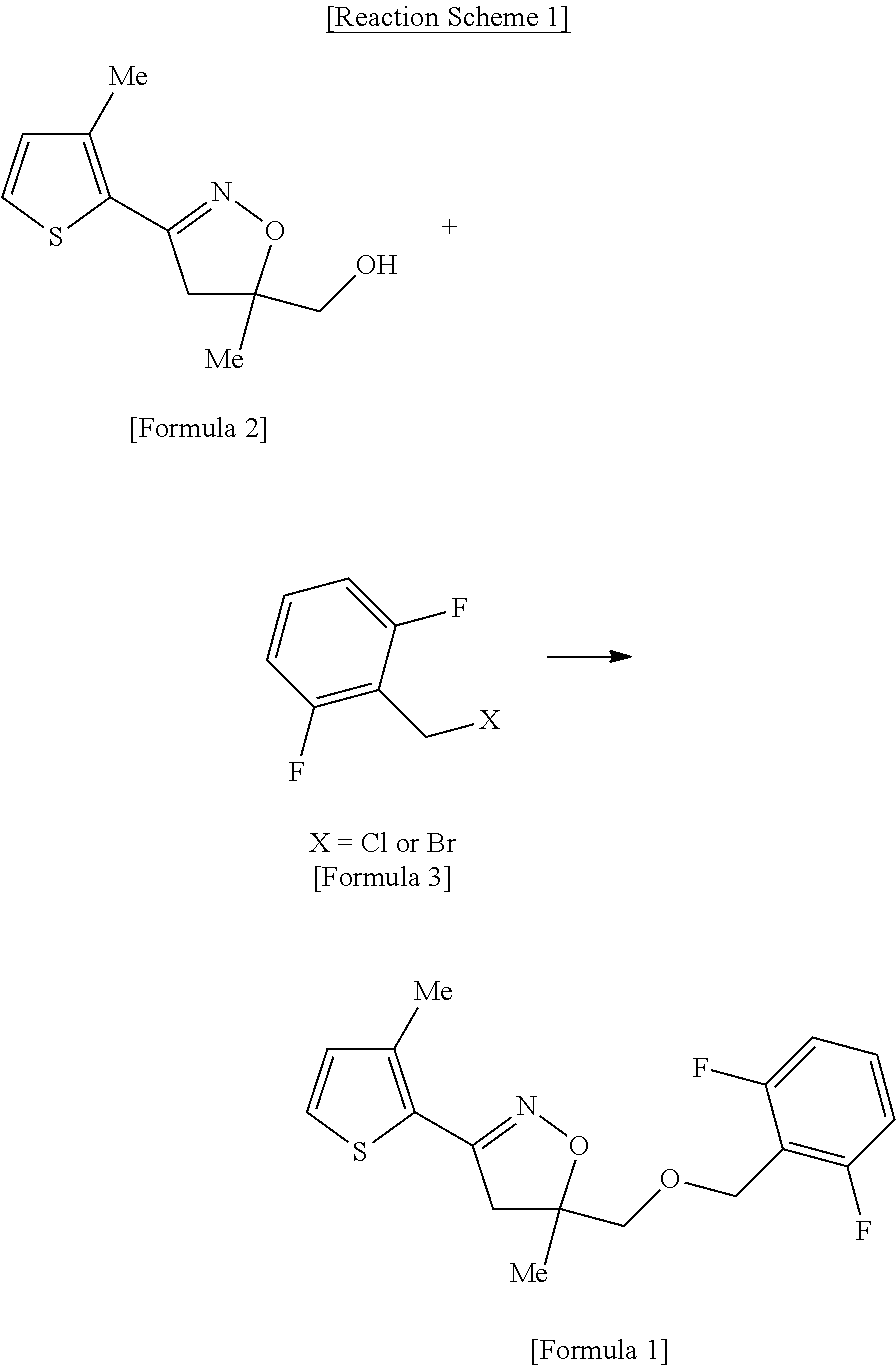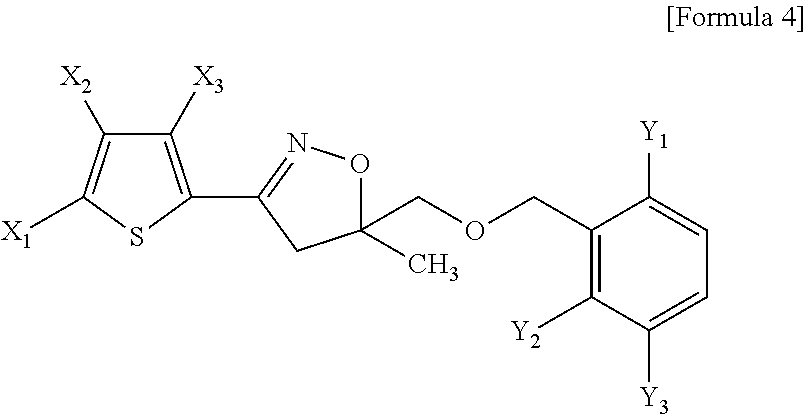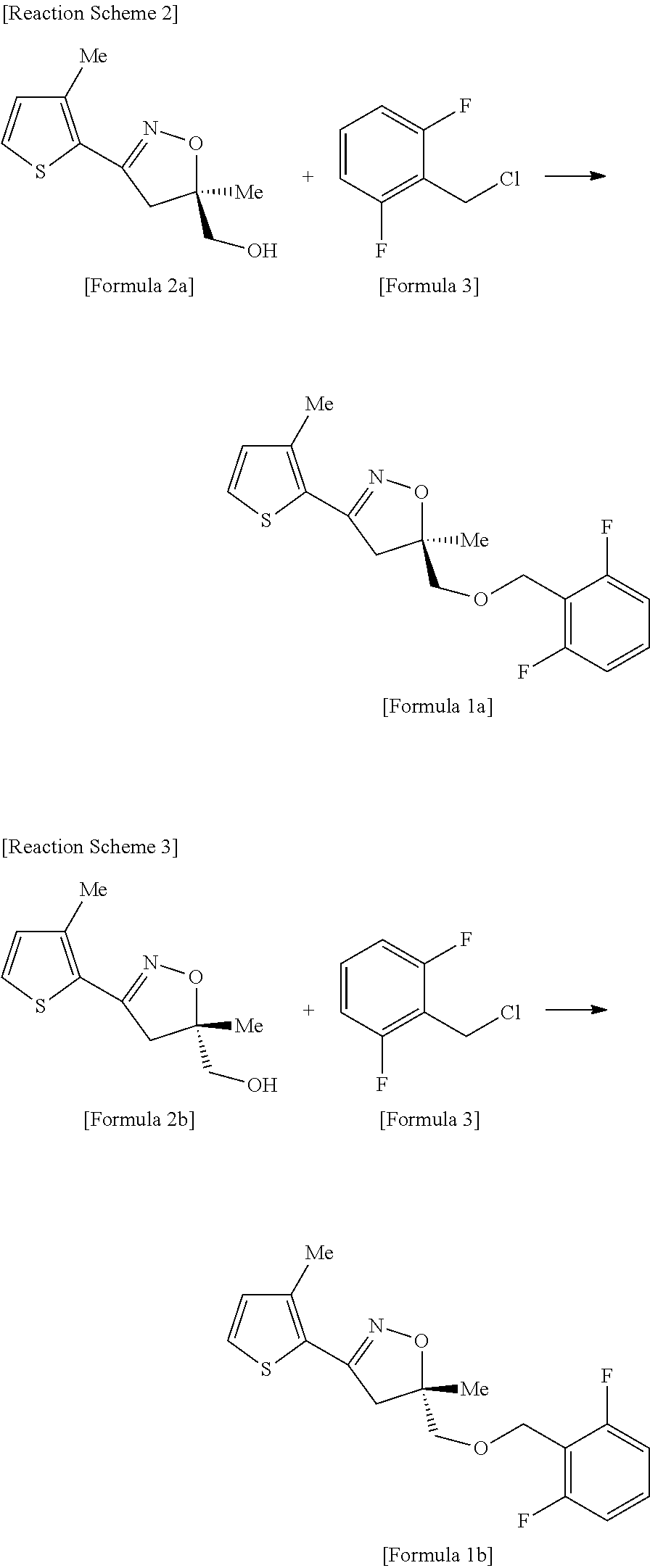Industrial method for the preparaton of high-purity methiozolin
a technology of high-purity methiozolin and industrial method, which is applied in the direction of organic compounds/hydrides/coordination complex catalysts, organic chemistry, physical/chemical process catalysts, etc., can solve the problems of low yield, unsuitable industrial synthesis for mass production, and inconvenient industrial synthesis, etc., to achieve herbicidal activity, improve crop yield, and high turf/crop selectivity
- Summary
- Abstract
- Description
- Claims
- Application Information
AI Technical Summary
Benefits of technology
Problems solved by technology
Method used
Image
Examples
example 1
Synthesis of Methiozolin
[0028]Toluene (18 L), 4,5-dihydro-5-methyl-3-{(3-methylthiophene-2-yl)-isoxazole-5-yl}methanol (25 kg, 118 mol), tetrabutylphosphoniumbromide (1.0 kg), and 25% NaOH solution (95 kg, 593 mol) were added to a 250 L stainless reactor, and the mixture was stirred. A solution of 2,6-difluorobenzylchloride (21 kg, 129 mol) dissolved in toluene (50 L) was added to the reaction mixture, and the resultant was heated at a temperature of 55 to 60° C. for 6 hours and then cooled to room temperature, and an organic layer was isolated. Activated carbon (2 kg) was added to the isolated brown organic layer and then the reaction mixture was stirred for about 0.5 hr, and filtered to remove the activated carbon. The residual solution was loaded into a 250 L reactor, and distillation was performed under reduced pressure at a temperature of 60° C. to remove toluene, and isopropanol (120 L) was added to the residue which was completely dissolved at a temperature of about 50° C. Th...
example 2
Synthesis of Methiozolin
[0029]Toluene (73 L), 4,5-dihydro-5-methyl-3-{(3-methyl thiophene-2-yl)-isoxazole-5-yl}methanol (100 kg, 473 mol), tetrabutylphosphonium bromide (5.1 kg), and 25% NaOH solution (379 kg, 2,368 mol) were loaded into a 1,000 L stainless reactor and the mixture was stirred. A solution of 2,6-difluorobenzylchloride (84.6 kg, 520 mol) dissolved in toluene (200 L) was added to above reaction mixture, and the resultant was stirred at a temperature of 60 to 65° C. for 20 hours, and then cooled to room temperature, and an organic layer was isolated. The isolated organic layer was washed twice with water (194 L×2), and then distilled under reduced pressure at a temperature of 90° C. to remove toluene. Then, isopropanol (47 L) and n-heptane (473 L) were added to the residue which was completely dissolved by heating at a temperature of 60 to 70° C.
The resulting solution was cooled at a temperature of 0° C. and placed for 12 hours at that temperature to give solid product ...
PUM
| Property | Measurement | Unit |
|---|---|---|
| temperature | aaaaa | aaaaa |
| temperature | aaaaa | aaaaa |
| temperature | aaaaa | aaaaa |
Abstract
Description
Claims
Application Information
 Login to View More
Login to View More - R&D
- Intellectual Property
- Life Sciences
- Materials
- Tech Scout
- Unparalleled Data Quality
- Higher Quality Content
- 60% Fewer Hallucinations
Browse by: Latest US Patents, China's latest patents, Technical Efficacy Thesaurus, Application Domain, Technology Topic, Popular Technical Reports.
© 2025 PatSnap. All rights reserved.Legal|Privacy policy|Modern Slavery Act Transparency Statement|Sitemap|About US| Contact US: help@patsnap.com



